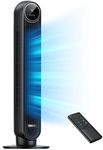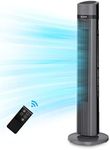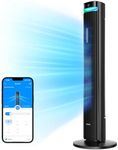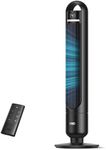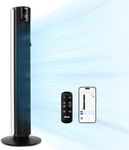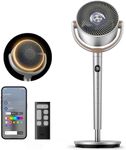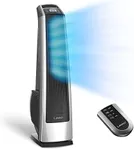Buying Guide for the Best Tower Fans
Choosing the right tower fan can make a big difference in your comfort during warm days. Tower fans are popular because they are slim, stylish, and can fit into tight spaces while providing good airflow. When shopping for a tower fan, it's important to think about where you'll use it, how much space you need to cool, and what features will make your experience more convenient and enjoyable. Understanding the key specifications will help you find a fan that matches your needs and lifestyle.Airflow Power (CFM)Airflow power, often measured in cubic feet per minute (CFM), tells you how much air the fan can move. This is important because a higher CFM means the fan can cool a larger area or provide a stronger breeze. Lower CFM fans are suitable for small rooms or personal use, while higher CFM fans are better for larger spaces or if you want a more noticeable cooling effect. Think about the size of the room and how much cooling you need—if you just want a gentle breeze at your desk, a lower CFM is fine, but for a living room or bedroom, look for a higher CFM.
OscillationOscillation refers to the fan's ability to rotate from side to side, spreading air across a wider area. This is important if you want to cool more than one spot or share the fan with others in the room. Some fans have a wide oscillation angle, which covers more space, while others have a narrower range. If you need to cool a whole room or multiple people, choose a fan with a wide oscillation. If you only need airflow in one direction, oscillation may not be as important.
Speed SettingsSpeed settings let you control how fast the fan blades move, which changes the strength of the airflow. More speed options give you greater control over comfort, letting you choose a gentle breeze or a strong wind. Fans with just a few speeds are simple to use, while those with more settings offer finer adjustments. If you like to customize your comfort or use the fan in different situations (like sleeping vs. working out), look for more speed options.
Noise LevelNoise level is how loud the fan is when running, usually measured in decibels (dB). This is important if you plan to use the fan while sleeping, working, or watching TV. Quieter fans are better for bedrooms and offices, while a little noise might not matter in a living room or kitchen. If you are sensitive to noise, look for fans advertised as 'quiet' or check the dB rating—lower numbers mean less noise.
Size and HeightThe size and height of a tower fan affect where you can place it and how well it circulates air. Taller fans can blow air at a higher level, which is good for cooling people sitting or standing, while shorter fans are better for floor-level cooling. Consider the space where you’ll use the fan—if you have limited floor space, a slimmer or shorter model might fit better, but for larger rooms, a taller fan can be more effective.
Control OptionsControl options include how you operate the fan, such as buttons, touch panels, remote controls, or even smart features like app or voice control. This is important for convenience—if you want to adjust settings from across the room, a remote or smart control is helpful. If you prefer simplicity, basic manual controls may be enough. Think about how you’ll use the fan and whether you want to control it from a distance or with extra features.
Timer and Sleep ModesA timer lets you set the fan to turn off after a certain period, and sleep modes often reduce speed and noise for nighttime use. These features are important for saving energy and ensuring comfort while you sleep. If you want the fan to run only for a set time or need a quieter setting at night, look for models with these options. If you plan to use the fan mostly during the day or while awake, these features may be less important.
Filter and Air PurificationSome tower fans include filters or air purification features to help remove dust, pollen, or odors from the air. This is important if you have allergies or want cleaner air in your home. If air quality is a concern, look for fans with built-in filters or purification systems. If you just need cooling, this feature may not be necessary.
